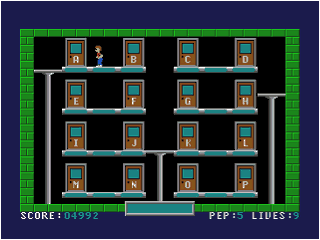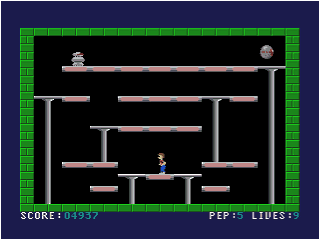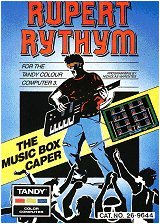 After the success of Donut Dilemma for
the Tandy Color Computer, I immediately went to work on another game. This
time it was to be a game specifically for the new Color Computer 3 and exploit
the enhanced graphics and speed of this machine. There was no need to develop
tricks to create extra colors. The new machine could display 16 colors selectable
from a palette of 64. It had a higher resolution of 320 x 225 pixels (or
640 x 225 in 4 colors) compared to the old model's 128 x 192 pixels in 4
colors (or 256 x 192 in 2 colors). After the success of Donut Dilemma for
the Tandy Color Computer, I immediately went to work on another game. This
time it was to be a game specifically for the new Color Computer 3 and exploit
the enhanced graphics and speed of this machine. There was no need to develop
tricks to create extra colors. The new machine could display 16 colors selectable
from a palette of 64. It had a higher resolution of 320 x 225 pixels (or
640 x 225 in 4 colors) compared to the old model's 128 x 192 pixels in 4
colors (or 256 x 192 in 2 colors).
And once again I chose a platform style game. I wanted to add more of a puzzle
element to the game and came up with the following plot line...
Original Story Pretext
As tired as he was, the loud ringing sound could not be blocked out by
his phenomenal level of exhaustion. Slowly, he opens his eyes and pushing
his remote percussion keyboard aside, proceeds to answer the phone.
'"Rupert! Wake up!" frantically cries Rupert's manager, Bill Boombox.
"Hardrock Harry, manager of Music Box Records has stolen all your musical
manuscripts and plans to release YOUR song under HIS name!!! Your entire
future is at stake! Get those manuscripts back! Fast!!" CLICK!
You must help Rupert infiltrate Music Box Records and collect all his
stolen notes which are scattered throughout the complex. Ride the crazy elevators
and beware of the security robots on patrol. After collecting all the stolen
notes, you must work out their correct sequence before Rupert can perform
his first live concert which will lift him to international fame and
fortune!
Game Development
 Rupert Rythym has nice graphics. I
used nice metallic shading on the elevator poles and platforms to give a
slight 3D look and Rupert himself looks great! There is a lot of sampled
sound used in the game... from Rupert's "Hey!" to the various percussion effects
that comprise the stolen tunes. Rupert Rythym has nice graphics. I
used nice metallic shading on the elevator poles and platforms to give a
slight 3D look and Rupert himself looks great! There is a lot of sampled
sound used in the game... from Rupert's "Hey!" to the various percussion effects
that comprise the stolen tunes.
This game uses the same techniques I had been using since the TRS-80 Model
1 games. The sprite animation engine was almost identical in operation and
while the graphics looked very clean with no flickering, no jerky movement and
all the moving objects (sprites) gliding over the background elements perfectly,
it was a bit slow. I had opted to move everything by pixel-pixel movements
and when using a graphic mode that takes up 32K, it proved to be a burden
on the graphics engine. I was also still generating sound by the old method
that I had been using and this also came with a speed penalty. I knew I had
to update my graphic and sound routines in the future to better suit this
new computer.

The Main Hallway |

One of the 16 rooms |
As mentioned before, this was a platform game with a puzzle element. The
way this worked was that the player had to retrieve his stolen manuscript
that was torn up into 16 pieces and distributed amongst the 16 rooms of the
Boombox Records building.
When the player first starts, he is in the main hallway where he chooses
to enter one of the 16 doors marked from A to P. On entering a door, you
appear in a room with moving elevators, red platforms and various security
droids called DROGS (DROid GuardS).In order to retrieve the stolen
note from this room, the player must walk over each platform and change its
color from red to cyan. You then are returned to the main hall where you
can use the small control panel at the bottom of the screen to manipulate
the order of the collected notes.
Once you have retrieved all the notes AND manipulated them in the correct
sequence, you are taken to a new screen with a stage and instruments and
you play the entire song before a "live audience". The game ends and you
become famous. :) I hated this game.
My personal opinion of this game was that I could have improved the gameplay
a bit more. I feel that I concentrated more on the puzzle element and didn't
give enough thought to the arcade game element. Apart from the game having
a bit of a slow feel to it, I believe that there is also too much "standing
around" on each screen as the player waits for the moving elevator to reach
his platform. In hindsight, I should have made the platform move immediately
to the players platform rather than let it carry on in it's fixed rhythm
of movement.
Marketing and Sales
 First of all, the word "Rythym" is
not how we spell the word in Australia as a US review once stated. That was
a real spelling mistake on my behalf. I take full responsibility! First of all, the word "Rythym" is
not how we spell the word in Australia as a US review once stated. That was
a real spelling mistake on my behalf. I take full responsibility!
My excuse was that "Rythym" is a commercial twist on the word "Rhythm" used
as Rupert's surname, his "fame name" if you like. Of course
that's bollucks but I figured a small lie won't hurt
and I may even get away with it.... I did!! :)
With Rupert Rythym, I decided to go upmarket with the graphic artwork for
the packaging. I drew a sketch of what I wanted the completed artwork to look
like and paid a commercial artist to do me a nice black and white cover.
I then just had to color it myself, add the game screenshot, Tandy Color
Computer logo and catalogue number and it was done.
I had the covers color printed to ensure a high quality.
With my sales momentum generated by Donut Dilemma, Rupert Rythym was snapped
up by Tandy Australia. This time, without the support of a Christmas computer
package, it sold 850 copies to Tandy Australia. Still a respectable number
and I could still keep wearing my "I'm not a failure" t-shirt with pride.
|